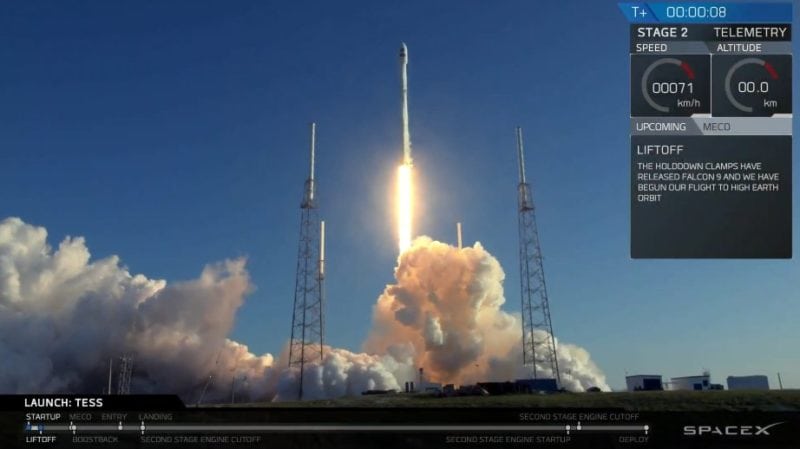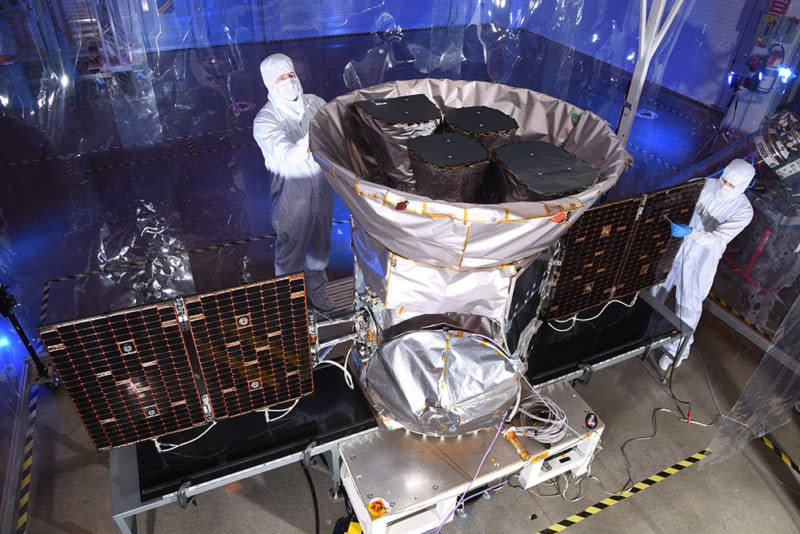Latest News

SpaceX Falcon 9 lifts off from Space Launch Complex 40 at Cape Canaveral Air Force Station, Florida on Wednesday, April 18 carrying NASA’s TESS mission. Photo: SpaceX
SpaceX successfully launched the Transiting Exoplanet Survey Satellite (TESS) for NASA from Space Launch Complex 40 at Cape Canaveral Air Force Station, Florida. TESS, built by Orbital ATK, will perform a survey of the entire sky to identify planets ranging from Earth-sized to Jupiter-sized, orbiting a wide range of stellar types and in various orbital regimes.
Liftoff occurred on Wednesday, April 18th at 6:51 p.m. EDT. The Falcon 9 rocket delivered TESS to a highly elliptical orbit and the spacecraft was deployed approximately 49 minutes after liftoff, SpaceX stated.
Orbital ATK completed the satellite’s post-launch health checks and configuration activities in preparation for a series of in-space maneuvers, including a lunar gravitational assist, to reach its targeted highly-elliptical orbit. Once in-orbit testing has been completed, TESS will begin its initial two-year mission approximately 60 days after launch.
The principal goal of the TESS mission is to use four wide-field cameras to detect small planets around bright host stars in the solar neighborhood so that detailed characterizations of the planets and their atmospheres can be performed. Over the course of several weeks, TESS will use six thruster burns to travel in a series of progressively elongated orbits to reach the Moon, which will provide a gravitational assist so that TESS can transfer into its 13.7-day final science orbit around Earth. After approximately 60 days of check-out and instrument testing, the spacecraft will begin its work.
For this two-year survey mission, scientists divided the sky into 26 sectors. TESS will use four unique wide-field cameras to map 13 sectors encompassing the southern sky during its first year of observations and 13 sectors of the northern sky during the second year, altogether covering 85 percent of the sky.

NASA’s Transiting Exoplanet Survey Satellite (TESS). Photo: OrbitalATK
TESS will be watching for phenomena called transits. A transit occurs when a planet passes in front of its star from the observer’s perspective, causing a periodic and regular dip in the star’s brightness. More than 78 percent of the approximately 3,700 confirmed exoplanets have been found using transits.
NASA’s Kepler spacecraft found more than 2,600 exoplanets, most orbiting faint stars between 300 and 3,000 light-years from Earth, using this same method of watching for transits. TESS will focus on stars between 30 and 300 light-years away and 30 to 100 times brighter than Kepler’s targets.
The brightness of these target stars will allow researchers to use spectroscopy, the study of the absorption and emission of light, to determine a planet’s mass, density and atmospheric composition. Water, and other key molecules, in its atmosphere can give us hints about a planets’ capacity to harbor life.
Through the TESS Guest Investigator Program, the worldwide scientific community will be able to conduct research beyond TESS’s core mission in areas ranging from exoplanet characterization to stellar astrophysics, distant galaxies and solar system science.
“The targets TESS finds are going to be fantastic subjects for research for decades to come,” said Stephen Rinehart, TESS project scientist at NASA’s Goddard Space Flight Center in Greenbelt, Maryland. “It’s the beginning of a new era of exoplanet research.”
Following stage separation, Falcon 9’s first stage successfully landed on “Of Course I Still Love You,” SpaceX’s droneship stationed in the Atlantic Ocean.
Get the latest Via Satellite news!
Subscribe Now